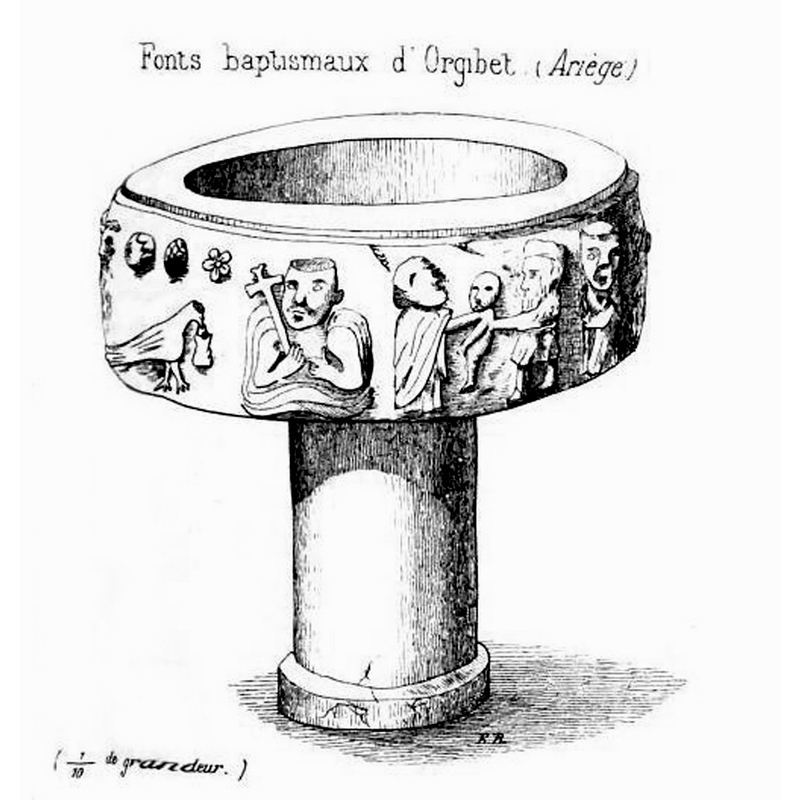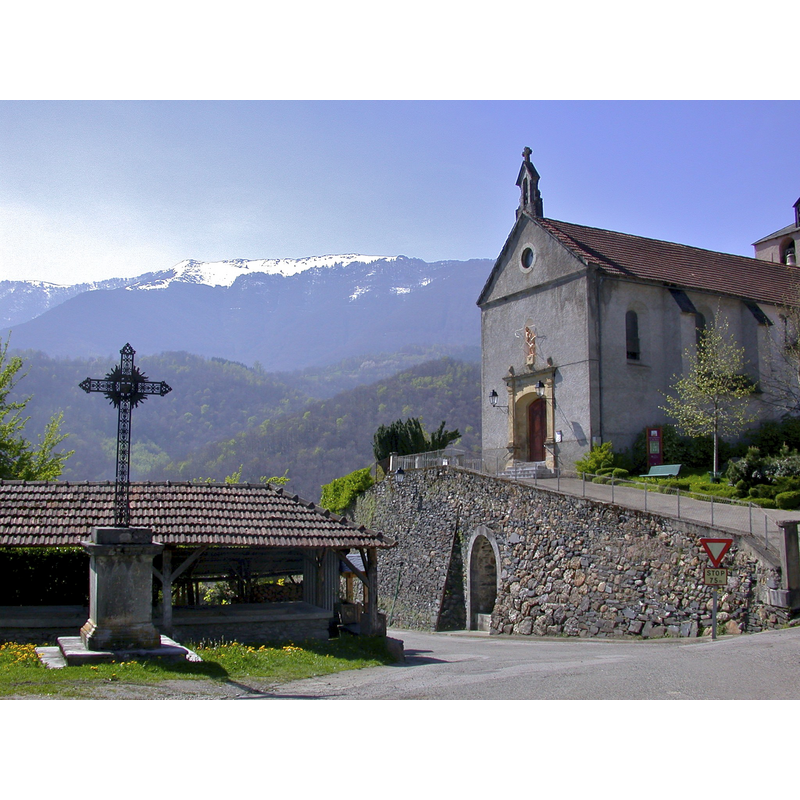Orgibet

Image copyright © [in the public domain]
PD
Results: 11 records
New Testament - public life of Christ - Christ in the river Jordan
animal - bird
animal - mammal - dog
design element - motifs - floral - rosette
human figure - head - 3
information
sacrament - baptism
symbol - shield?
view of church exterior in context - southwest end
view of font
INFORMATION
FontID: 03002ORG
Object Type: Baptismal Font1
Church/Chapel: Eglise paroissiale de l’Assomption [aka Notre-Dame-de-l'Assomption]
Church Patron Saints: The Assumption of St. Mary
Church Location: 141 Le Village, 09800 Orgibet, France -- Tel.: +33 5 61 66 05 89
Country Name: France
Location: Ariège, Occitanie
Directions to Site: Orgibet is located SW of Saint-Girons, 53 km from Luchon, in the valley of Saint-Lary
Ecclesiastic Region: Diocèse de Pamiers
Historical Region: Le Castillonnais en Couserans / Midi-Pyrénées
Font Location in Church: Inside the church
Century and Period: 13th century, Late Romanesque / Early Gothic?
Cognate Fonts: Samer? / Pont--Mousson? [cf. FontNotes]
Church Notes: present church is 18thC, built on the site of a Romanesque church there
Font Notes:
Click to view
The baptismal font here is described and illustrated in Richard (1874) as a crude work of local stone which nonetheless merits the archaeologists' interest for the uniqueness of its ornamentation and the difficulties of interpretation which its decorative programme poses ["Faite en pierre du pays, sculptée avec des préoccupations artistiques évidentes et une maladresse des plus grossières, cette cuve m'a paru mériter l'attention des archéologues, et par la singularité de son ornementation, et par la diflicullé que présente l'interprétation même de ses figures"]; the basin has in its upper rim an indentation all around to accommodate a font cover; many of the outer figures are reported disfigured or missing, a damage which Richard (ibid.) blames not on fortuitous causes, but "à la main des hommes et probablement des révolutionnaires". Richard (ibid.) identifies a scene of the Baptism of Christ in the Jordan, with the characteristic of a clean-shaven and un-haloed Christ that he refers also to the baptismal font at Pont à Mousson; Richard recognises that this figure might represent John the Baptist, but he is inclined to believe it presents Christ; next to this figure (L->R) is a scene that, again, in Richard's description (ibid.), a tonsured (?) long-robed man receives in his extended arms a naked child from a man bearing a long beard; to the right are two other long-robed figures; the one on the left leans on a staff and has a hood on his back, whereas the figure on the right has been mutilated ["le reste a disparu sous de nombreux coups de ciseau"]; on to the right is a dog which, interestingly, is identified by Richard as a Pyrenean Mastiff [Canis lupus familiaris] ["Derrière lui marche un chien dont la forte encolure, les oreilles droites, la queue redressée, reproduisent les principaux caractères de la race des Pyrénées"]; this whole grouping, dog included, is seen by Richard (ibid.) as a country baptism ["un baptême dans la montagne"], the presence of the dog being nothing out of the ordinary but, rather, a symbol of fidelity ["la présence d un chien n'a donc rien d'insolite: ce chien peut, du reste, symboliser la fidélité"]. The identification of the other elements continues in Richard (ibid.): three human faces, a string of pearls, a much damaged figure, something that resembles a charged shield, followed by seven other motifs (fleurons, pine cones, two human faces, etc.) and, below, a bird that relates to the main figure, a well-known symbol in baptism; Richard (ibid.) notes that, though he does not want to make too much of the numbers three and seven, these motifs could stand for the three theological virtues [i.e., faint, hope, charity], or the seven gofts of the Holy Ghost [i.e., wisdom, understanding, counsel, knowledge, fortitude, piety, and fear of the Lord]. Richard (ibid.) suggests the damaged shield and one the figure that existed next to it may well have been the local lord and his coat-of-arms, and that he would have been the donor of the font, offered to the church at Orgibet on the occasion of a baptism; this, surmises Richard (ibid.) was the sort of imagery that would have attracted the wrath of the iconoclastic evolutionaries ["Les destructeurs ont cédé à une autre haine qu'à la passion antireligieuse: la Révolution qui a brisé tant d emblèmes féodaux [...] la haine des iconoclastes"]; based on the presence of the shield and the floral upper tip of the cross Richard (ibid.) states that the font should not be dated earlier than the 13th century. In a later article Richard (1879) mentions the similarity of the clean-shaven Christ of Baptism of Christ scene on this font with that of the same in the font at Samer. A 13th-century font here is noted in Duclos (1886). Listed by Enlart (1902) as a 13th century font with a round basin, and ornamented with a Baptism scene. Corblet (1881-1882) describes it as a stone font ornamented with crudely carved scenes; one appears to represent Jesus in the river Jordan carrying a cross; another depicts a baptism scene in which the godfather is followed by a dog; there are also three human heads which, Corblet suggests, may symbolise the theological virtues. Listed in Palissy [ref.: PM09000490]: "fonts baptismaux [marbre] [...] Sur les flancs de la cuve, est sculptée une série de figures en relief représentant la cérémonie du baptème." The Orbiget web site [www.histariege.com/orgibet.htm#Patrimoine] [accessed 12 June 2016] quotes a description by Cl. Aliqot, Conservateur des Antiquités et Objets d’Art de l’Ariège: "Cet édifice abrite une belle cuve des fonts baptismaux, pédiculée, en pierre de grès et sculptée en fort relief. Ces sculptures représentent la Vierge et Joseph tenant l’Enfant Jésus, les Évangélistes et leurs animaux symboliques, des fleurs à sept pétales et des boules striées. Sa forme en demi- sphère semble justifier une datation du XIII° siècle." The font here is mentioned in Guérout (1962) as one of the later cognates of the early [11thC?] baptismal font at Bastanous [cf. BSI entry for Manas-Bastanous]. It is also mentioned, but not illustrated, by Norbert Breton in Premier millénaire [http://millenaire1.free.fr/408_9_7B_eglises_assomption_ariege.html#5] [accessed 18 July 2022]: "On signale l'existence de fonts baptismaux qui pourraient dater du XIIIe ou XIVe siècle." Mentioned in Jean Guérout [Fonts baptismaux de Bastanous. In: Bulletin Monumental, tome 120, n°3, année 1962. pp. 296-297; https://www.persee.fr/doc/bulmo_0007-473x_1962_num_120_3_8733_t1_0296_0000_4]
COORDINATES
Church Latitude & Longitude Decimal: 42.934119, 0.938086
Church Latitude & Longitude DMS: 42° 56′ 2.83″ N, 0° 56′ 17.11″ E
UTM: 31T 331755 4755561
MEDIUM AND MEASUREMENTS
Material: stone, sandstone
Font Shape: round (mounted)
Basin Interior Shape: round
Basin Exterior Shape: round
Diameter (inside rim): 57 cm*
Diameter (includes rim): 78 cm*
Basin Depth: 20 cm*
Basin Total Height: 31 cm*
Font Height (less Plinth): 47 cm* [part buried in the ground not measured]
Notes on Measurements: * Richard (1874: 374) [Palissy [ref.: PM09000490] has: "h = 47 ; d = 57 ; Dimension de la cuve : h = 31"]
REFERENCES
Corblet, Jules, Histoire dogmatique, liturgique et archéologique du sacrement de baptême, Paris: V. Palme, 1881-1882
Duclos, Henri Louis, Histoire des Ariégeois (comté de Foix, vicomté de Couserans, etc.): de l'esprit et de la force intellectuelle et morale dans l'Ariège et les Pyrénées centrales, Paris: Perrin, 1886
Enlart, Camille, Manuel d'archéologie française depuis les temps mérovingiens jusqu'à la Renaissance, Paris: Alphonse Picard & fils, 1902
Richard, Jules-Marie, "Les fonts baptismaux de Samer", 5 (1879), Bulletin de la Commission des antiquités départementales (Pas-de-Calais), 1879, pp. 41-44, pl.; p. 43
![[cf. FontNotes]](/static-50478a99ec6f36a15d6234548c59f63da52304e5/compressed/0160613002_compressed.png)

